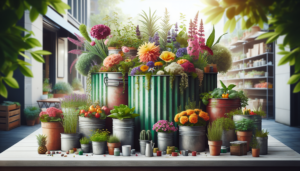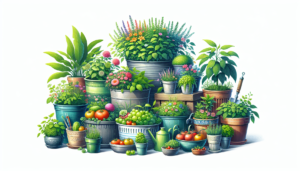If you’re searching for a simple and rewarding way to dive into the world of gardening, look no further than Kangkong container gardening. Whether you have limited space or simply want to add a touch of greenery to your living environment, this beginner’s guide will walk you through the ins and outs of growing kangkong in containers. From selecting the perfect container to nurturing your plants with care, this article will equip you with the knowledge and confidence to embark on your very own Kangkong container gardening journey. So roll up your sleeves, grab your gardening gloves, and let’s get started!
Choosing the Right Container
Size of the Container
When it comes to growing kangkong in containers, one of the first things you need to consider is the size of the container. Kangkong plants require enough space for their roots to spread out and grow. A container with a diameter of at least 12 inches is recommended to provide ample room for the plant to flourish. However, if you have limited space, you can opt for smaller containers, such as 8-inch pots, as long as you are prepared to be diligent with watering and maintenance.
Material of the Container
The material of the container is another crucial factor to consider. While kangkong can grow in various types of containers, it is best to choose containers made of sturdy and durable materials. Plastic or terracotta pots are popular choices for kangkong container gardening. Plastic containers are lightweight and affordable, while terracotta pots offer better breathability for the roots. Whichever material you choose, ensure that the container has good drainage holes to prevent waterlogging and maintain proper moisture levels.
Selecting the Ideal Location
Amount of Sunlight
Kangkong plants thrive in locations with ample sunlight. Ideally, they need at least six to eight hours of direct sunlight daily. Find a spot in your garden or balcony that receives maximum sunlight throughout the day. If you have limited access to sunlight, you can use artificial grow lights to supplement the natural light. Place the container in a well-lit area to ensure your kangkong plants receive the necessary light for healthy growth.
Temperature Requirements
Kangkong plants prefer warm and tropical climates. They thrive in temperatures ranging from 70°F to 90°F (21°C to 32°C). Avoid exposing them to temperatures below 50°F (10°C), as they are sensitive to cold weather. If you live in a region with colder winters, it is advisable to grow kangkong indoors or provide protective coverings to shield them from frost. Maintaining a consistent temperature within the suitable range is essential for the optimal growth of your kangkong plants.
Preparing the Container
Cleaning the Container
Before planting your kangkong, it is crucial to clean the container thoroughly to remove any dirt, dust, or debris. Use a mild detergent and scrub the container gently to ensure it is free from any harmful pathogens or remnants of previous plants. Rinse the container thoroughly with clean water and allow it to dry completely before proceeding with planting. Cleaning the container helps create a clean and healthy environment for your kangkong plants.
Drainage Holes
Proper drainage is essential for kangkong plants to prevent waterlogged roots and avoid the risk of root rot. Ensure that your container has sufficient drainage holes at the bottom to allow excess water to escape. If your container does not have pre-drilled holes, create them using a drill or hammer and nail. Adequate drainage will help maintain the right moisture levels in the soil and promote healthy root development.
Choosing the Right Soil
Well-Draining Soil
Kangkong plants thrive in well-draining soil that retains moisture without becoming waterlogged. A suitable soil mix can be prepared by combining equal parts of garden soil, compost, and perlite or sand. This mixture helps promote good drainage while providing the necessary nutrients for your kangkong plants to flourish. Avoid using heavy clay soils that tend to retain water, as they can hinder root growth and lead to root diseases.
Nutrient-Rich Soil
To ensure healthy growth and abundant foliage, it is essential to provide your kangkong plants with nutrient-rich soil. Incorporate organic matter such as compost or well-rotted manure into the soil mix. This will enrich the soil with essential nutrients and improve its fertility. Additionally, you can use a slow-release organic fertilizer high in nitrogen during planting, which will gradually release nutrients and sustain your kangkong plants throughout their growth cycle.
Starting from Seeds or Seedlings
Sowing Kangkong Seeds
If you choose to start your kangkong plants from seeds, it is best to sow them directly into the container. Fill the container with the prepared soil mix, ensuring it is moist but not waterlogged. Sow the seeds evenly on the surface and cover them lightly with a thin layer of soil. Keep the soil consistently moist during germination, which usually takes around 7 to 10 days. Once the seedlings emerge, thin them out, leaving a spacing of about 6 inches between each plant to allow for proper growth.
Transplanting Seedlings
Transplanting seedlings is an easier and quicker way to get your kangkong container garden started. You can purchase kangkong seedlings from nurseries or propagate them from seeds in a separate nursery tray. When the seedlings have grown to around 3 to 4 inches in height, they are ready for transplantation. Gently remove the seedlings from the nursery tray, taking care not to damage their delicate roots, and transplant them into the prepared container. Ensure the soil is moist and settle the seedlings firmly, keeping a spacing of 6 inches between each plant.
Watering and Humidity
Watering Requirements
Consistent and adequate watering is crucial for the healthy growth of kangkong plants. These leafy greens have high water needs and prefer consistently moist soil. Water your kangkong regularly, keeping the soil evenly moist. However, be cautious not to overwater, as excessively wet conditions can lead to root rot. Monitor the moisture levels by checking the soil’s top inch. If it feels dry, it’s time to water. Adjust the frequency of watering based on the weather conditions, ensuring that the soil remains moist but not waterlogged.
Maintaining Optimal Humidity
Kangkong plants thrive in humid environments. To maintain optimal humidity levels, you can follow a few simple techniques. Grouping plants together creates a microclimate that helps increase humidity levels around the plants. Misting the leaves with water regularly or placing a tray filled with water near the plants can also help increase humidity. However, ensure that the leaves are not constantly wet, as excessive moisture can lead to fungal diseases. Providing a humid environment will promote vigorous growth and lush foliage in your kangkong plants.
Fertilization and Nutrients
Choosing the Right Fertilizer
To ensure your kangkong plants receive the necessary nutrients, it is essential to choose the right fertilizer. A balanced, slow-release fertilizer with a higher nitrogen content is ideal for kangkong, as it promotes vigorous leafy growth. During the initial stages, you can incorporate a complete organic fertilizer into the soil mix or use liquid organic fertilizers diluted according to package instructions. As the plants grow, continue to fertilize every four to six weeks to maintain nutrient levels for a bountiful harvest.
Frequency of Fertilization
Maintaining a consistent fertilization schedule is crucial for the proper development of your kangkong plants. Initially, you can apply a complete organic fertilizer during planting or when the seedlings are transplanted. As the plants establish themselves, continue fertilizing every four to six weeks throughout the growing season. Monitor the plant’s growth and adjust the frequency and dosage of fertilizer if necessary. Remember, over-fertilization can lead to excessive leaf growth at the expense of nutrient uptake, so follow the instructions on the fertilizer package carefully.
Pest and Disease Control
Common Pests
While kangkong is generally a hardy plant, it can still be susceptible to certain pests. The most common pests that can affect kangkong plants include aphids, slugs, and snails. Aphids feed on the sap of the leaves, causing distortion and stunted growth. Slugs and snails thrive in moist conditions and can chew through the leaves, resulting in unsightly damage. Regularly inspect your plants for any signs of pest infestation and take prompt action to control them.
Preventing and Treating Diseases
Kangkong plants can also be prone to fungal diseases such as powdery mildew and leaf spot. To prevent these diseases, provide ample spacing between plants to improve air circulation, as good airflow helps prevent the buildup of moisture and fungal growth. Water at the base of the plants and try to avoid wetting the leaves, as this can create a favorable environment for fungal infections. If necessary, you can use organic fungicides or other natural remedies to treat these diseases. Early detection and immediate action are key to maintaining healthy kangkong plants.
Harvesting Kangkong
Identifying Ready-to-Harvest Kangkong
Once your kangkong plants have reached maturity, usually around 30 to 45 days after planting, you can start harvesting the leaves and stems. Look for vibrant, healthy leaves that are dark green in color. Avoid harvesting the central shoot as it promotes further growth of the plant. Instead, selectively harvest the outer leaves and tender stems to encourage continuous regrowth. Regular harvesting will keep your plants productive and provide you with a fresh supply of delicious kangkong for your culinary needs.
Harvesting Techniques
To harvest kangkong, simply grasp the stem near the base with one hand and use the other hand to snap or cut the stem at the desired length. For young and tender kangkong, harvesting the entire shoot can be done by cutting it off above the soil level. Be sure to use a sharp, clean pair of scissors or shears to avoid damaging the plant. Handle the harvested kangkong with care to prevent bruising or wilting. Immediately wash the leaves and stems before using them in your favorite dishes to ensure optimal freshness.
Taking Care of the Container
Trimming and Pruning
Regular trimming and pruning of your kangkong plants are essential for maintaining their shape and promoting healthy growth. Trim away any yellowing or damaged leaves to prevent the spread of diseases and pests. Prune back overgrown stems to encourage bushier growth. Aim to maintain a neat and tidy appearance while ensuring there is ample space for each plant to grow. Pruning also helps improve airflow and light penetration, which are crucial for healthy vegetation.
Container Maintenance
Proper maintenance of the container is necessary for the overall health of your kangkong plants. Regularly check the drainage holes to ensure they are not clogged and clear away any debris that may accumulate in the container. If the container becomes too heavy or the plants outgrow it, consider repotting them into a larger container to provide sufficient space for their roots. Additionally, periodically inspect the container for signs of wear or damage and replace it if necessary. Taking care of the container will ensure that your kangkong plants continue to thrive and produce abundant harvests.
In conclusion, kangkong container gardening offers a convenient and rewarding way to grow this leafy green vegetable in your own home. By carefully selecting the right container, preparing the soil, providing suitable conditions, and practicing proper care and maintenance, you can enjoy a flourishing kangkong garden and savor the fresh, nutritious produce straight from your own harvest. With a little dedication and attention, you can become an expert at kangkong container gardening and experience the joy of growing your own food. Happy gardening!







